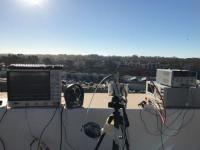| www.tmatlantic.com
Test & Soldering Equipment On-line Store |
|
D.E.V.I.C.E. (Wiki)Calculators Services |
|||||
Keysight Technologies, UC San Diego Collaborate to Prove Viability of 5G Communication with Record-Setting Data Rates of 2 Gbps at 300 m, 4 Gbps at 100 m
12/20/2016 Keysight Technologies, Inc., with the University of California San Diego (www.ece.ucsd.edu) announced the world's longest bidirectional phased-array link in the 60 GHz band. At a link distance of 300 m, the 32-element array achieved a data rate of greater than 2 Gbps over all scan angles up to ±45 degrees. Data rates were 4 Gbps at 100 m and 500 Mbps at 800 m over most scan angles. Initial tests by a leading wireless provider suggest the system can deliver content to eight homes at a time at up to 300 m.The entire phased array consumed 3 to 4 W of DC power in either its transmit (Tx) or receive (Rx) modes. This is due to the high-performance system-on-a-chip (SoC) designs UC San Diego created using the third-generation silicon germanium BiCMOS standard buried collector (SiGe BiCMOS SBC18H3) process from TowerJazz, the global specialty foundry leader. Keysight hardware and software enabled rapid prototyping of the system, as well as link equalization and state-of-the-art performance measurements at 2 GHz modulation bandwidth. Central hardware elements were the M8195A arbitrary waveform generator, E8267D PSG vector signal generator and DSOS804A high-definition oscilloscope. UC San Diego used Keysight's Signal Studio software to define and generate the 60 GHz 802.11ad waveform, which was the basis for development. Keysight's 81199A Wideband Waveform Center software helped the team link Tx and Rx, apply digital pre-distortion and improve error vector magnitude (EVM) performance. The team also used Keysight's 89600 VSA software to perform demodulation and analysis of advanced signals. "This is the second time UC San Diego has worked with Keysight to demonstrate high-performing phased-array 5G communication links, now achieving gigabit-per-second speeds at previously unimagined ranges and with extremely low power consumption," said Gabriel M. Rebeiz, member of the U.S. National Academy of Engineering, distinguished professor and wireless communications industry chair at the UC San Diego Jacobs School of Engineering. "Keysight equipment and software, along with the SBC18H3 technology from TowerJazz, have been instrumental to our success." The H3 process is part of the TowerJazz Terabit Platform, which includes state-of-the-art 240 GHz SiGe bipolar transistors and CMOS analog devices. With unequalled low noise, the platform is a technology of choice for use at 60 GHz and in high-frequency applications such as radar, optical wireless communication and emerging wireless standards. Key contributors to the UC San Diego effort were Bhaskar Rupakula and Ahmed Nafe, graduate students in electrical engineering; and Samet Zihir and Tsu-Wei Lin, electrical engineering post-doctoral fellows. All praised the quality of Keysight's hardware, software and technical support. "The results of our continuing collaboration with UC San Diego and the demonstrated advances in millimeter-wave technology provide critical proof of viability for 5G, especially the fixed-broadband use case that is the focus of many pre-standardization efforts," said Dr. Mark Pierpoint, vice president and general manager, Keysight Internet Infrastructure Solutions. "We are continuing to invest to create innovative solutions that enhance and accelerate the development of next-generation wireless communications."
All Keysight products used in the development of the 5G communication link are available now. UC San Diego's phased-array SoCs are also now available. Additional information can be found at www.keysight.com/find/5GTestbed.
Related Information:
Industry news
|
Site mapPrivacy policyTerms of Use & Store PoliciesHow to BuyShippingPayment




|



